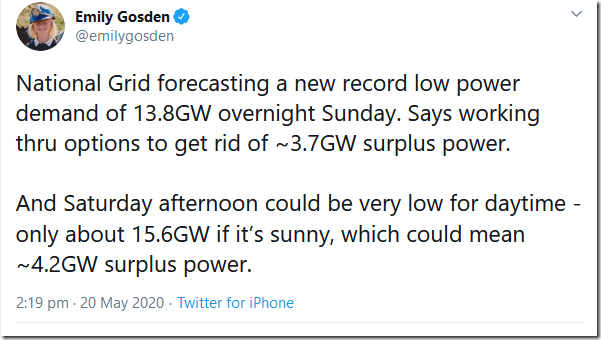National Grid Facing Unprecedented Wind Power Surplus
May 21, 2020
By Paul Homewood
https://twitter.com/emilygosden/status/1263097072649043968
With a windy weekend forecast, it sounds like constraint payments will be sky high!
15 Comments
Comments are closed.

Most of the comments in response to her are ludicrous too.
The government want to build more wind farms! Total madness. How much has it cost to turn off the windfarms this year? £££££££ Never mind, its only money.
If it’ s too hot, perhaps they can point the windmills back at the UK and reverse power them as giant cooling fans – everyone wins.
Wind is AWOL again, <0.9GW. I've also noticed that under these supply worries they've had lately, the BIOMASS has been running almost full wack throughout, and the CCGT goes right down. The proportion of UK electricity coming from tree burning must be increasing – lunacy.
If the wood pellets keep arriving, they have to burn them or risk a massive uncontrolled fire breaking out in a stockpile.
Also Drax can afford to undercut CCGT, as it will still get its guaranteed subsidy on top of the market price
http://joannenova.com.au/2020/05/solar-owners-worried-big-brother-aemo-wants-to-turn-off-their-panels-at-noon-in-emergencies
SNAP! Similar articles at at same time!
But in South Australia, and it’s solar that’s the problem!
Robert Christopher:
Roof top solar has been enthusiastically adopted in S.A. because of the high electricity charges. The ludicrously high Feed-in tariffs initially made it great for earlier adopters (thanks, I haven’t paid for electricity for 10 years**) but they have been reduced to roughly the current wholesale rate** so people installing solar are installing bigger and bigger systems to incease their rebate (chasing their tails).
As S.A. is fairly sunny, the surge in solar output is disrupting the market for wind generation.
The amount of household generation can only be estimated but the overall amount needed from the grid is dropping***. The authorities want an amount of reliable generation (gas, diesel) to prevent another State wide blackout, so wind farms are being curtailed (about 10% so far).
The politicians have now realised that the sun only shines during the day, so when it dips down, and demand soars in the peak evening time there is a grave risk of grid collapse, so they are subsidising home batteries. The grid controller is installing reactive storage (basically huge flywheels) to stabilise the frequency. Both cost lots of money and will drive up electricity prices again. This stabilisation used to be supplied free of charge by the coal fired power stations.
The Minister “in charge” of electricity wants to increase the share of renewables from 50% to 78% or more, so costs will rise and rise until the system collapses once again.
** which means those without solar get to pay more.
*** also the high cost of electricity (and government regulations) has driven many businesses either bankrupt or elsewhere, also reducing demand.
Thanks to S.A. for being the crash test dummies of saturation renewables 😬
The problems of either too much or insufficient electricity generation was first predicted several years ago. But nobody responsible for energy policy was listening (or understood). For about 20 years energy policy has been decided by idiots (just look at the list of successive energy ministers).
I discussed it at a Physics undergraduate workshop at Birmingham University, England in 1974 and, apart from slightly older technology, the problems were much the same.
I remember being asked why the Dutch were successful in pumping their country dry centuries ago. The answer is that they weren’t feeding a high quality Nation Grid. If the wind blew, water was pumped, if not, then not, but over a year it would even itself out.
For your delight we have an Imperial College study commissioned by Drax Electrical Insights.
“Dr Iain Staffell of Imperial College London said: “Britain’s electricity system is under pressure like never before, with both the country’s weather getting more extreme and a global pandemic testing its resolve.”
This, I think, though I don’t see the quote. Why don’t energy live news ever include links except to themselves?
https://electricinsights.co.uk/#/reports/report-2020-q1/detail/wind-power-surges-to-new-records?_k=kppmz0
The Blackout
https://electricinsights.co.uk/#/reports/report-2019-q3/detail/the-blackout?_k=e1tk5v
Thanks OB. That is an excellent summary of what happened last year, I think. Pretty unbiased and makes sense. The problem seems to have been the overall system stability, given different reactions to events by different generators – some of which made things worse. (Didn’t see the quote there either?)
I can’t think that having a larger percentage of power from wind helps, and it was the gleeful ‘we’re getting more power from wind than gas’ bit that did for me. I didn’t realise it when I first commented but Dr Stafell seems to author all the Drax Insights posts.